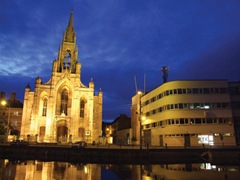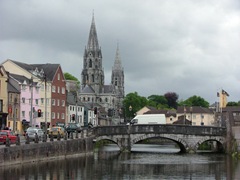A regional overview
 Cork is the largest county, and Ireland’s second biggest city is continuing to attract a strong level of foreign direct investment.
Cork is the largest county, and Ireland’s second biggest city is continuing to attract a strong level of foreign direct investment.
Spanning a total area of 7,454 km2 and over 1,100 km of coastline (second only to Mayo), Cork is the largest county in Ireland and contains the second largest city in the country. Approximately 10.5 per cent of Cork consists of forestry or woodland, and the county has 125 rivers and 32 lakes. The main rivers are the Lee, which runs through the city, the Bandon and the Blackwater. Mountain ranges in the county include the Boggeragh mountains, the Slieve Miskish range in the Beara peninsula and the Galtee mountains which span parts of Cork, Limerick and Tipperary, and is the highest inland mountain range in Ireland.
Cork city was established as a trading port, founded by Viking settlers in the early tenth century. The county was officially created when County Desmond (Deas Mhumhan/Southern Munster) was divided in 1606.
Cork is known as the rebel county. Though the term is often associated with Cork’s role in the War of Independence between 1919 and 1921 and the subsequent Civil War, it originates from the 15th century when several prominent members of the city, including the Mayor, went to England to aid Perkin Warbeck in trying to overthrow Henry VII in 1491.
Provisional census figures for 2011 show the combined population of Cork city and county was 518,128, with 118,912 living in the city and 399,216 in the rest of the county. Compared with the 2006 census the 2011 figures represent a 0.4 per cent decline for the city and a 10.3 per cent increase in county population. There is a Gaeltacht area in Cork, Muscraí, which includes Ballyvourney, Ballingeary, and Cape Clear island off the west Cork coast.
The Cork County Development Plan (2009- 2015) outlines the county in terms of four sub-areas:
• ‘metropolitan Cork’, which includes Cork city, its environs (within the county) and the metropolitan (or satellite) towns such as Ballincollig, Blarney, Cobh and Midleton;
• the ring area, outside metropolitan Cork, including Mallow (as the hub town), and towns such as Bandon, Fermoy and Youghal, which support rural hinterlands;
• north Cork, which includes the towns Kanturk, Charleville, Mitchelstown and Newmarket;
• west Cork, with towns such as Bantry, Castletownbere, Clonakilty and Skibbereen.
East Cork is contained within the metropolitan, ring and northern areas.
One of the challenges facing the city and county in recent years has been the threat of flooding. In November 2009 the river Lee burst its banks in places and high tide coincided with the enforced release of water from the Inniscarra hydro-electric dam. The quay walls at Grenville Place collapsed. Households had to be evacuated, clean water supplies were cut and the Mercy Hospital flooded. Western towns such as Bandon also experienced severe flooding resulting in communities being cut off and people evacuated. The damage from the flooding cost Cork City Council alone approximately €35 million whilst insurance claims for damage to commercial and household property were estimated to total €141 million. A Catchment Flood Risk Management Plan, setting out measures for the local authorities and the Office of Public Works to adopt in managing flood risk in the Lee catchment area, was published and submissions invited earlier this year.
Cork has substantial transport infrastructure. In terms of road networks, it has the M8 motorway from Cork to Dublin, and national roads such as the N20 from Limerick to Cork, the N22 from Cork to Tralee, the N25 (E20) from Cork to Waterford (and on to Rosslare Harbour) and the N27 from Cork city to Cork airport. The N72 from Dungarvan to Killarney is linked by towns such as Fermoy and Mallow, whilst the N71 connects the city to west Cork.
In terms of rail links, there are regular trains from Cork to Dublin, Limerick and Kerry, whilst the Cork suburban rail network serves Mallow, Cork, Midleton and Cobh.
Ferry links include the Cross River ferry from Rushbrooke to Passage West, and international ferries from Cork to Swansea and Ringaskiddy to Roscoff. There are also ferry services in west Cork to islands in the region.
Cork Airport was opened in 1960. In 2010 it served 2.43 million passengers, which marked a 12.4 per cent decrease on the number of passengers achieved in 2009. The airport serves 60 different routes and its three most popular destinations are London, Dublin and Amsterdam.
Universities
Cork has one university, an institute of technology and the National Maritime College of Ireland.
University College Cork was established in 1845 and is one of the four constituent colleges of the National University of Ireland. During the 2010-2011 academic year it had 18,820 full-time students, including 12,791 undergraduates, 3,641 postgraduates and 1,091 PhD students. The largest college in the university (in terms of students) is Arts, Celtic Studies and Social Sciences. Its research centres include the Alimentary Pharmabiotic Centre, the BioSciences Institute, the Cork Constraint Computation Centre and the Tyndall National Institute. UCC has a strong research base, and in the 2009-2010 academic year spent €83.8 million in this area.
The city is also home of Cork Institute of Technology, which has approximately 12,000 students, half of whom are full- time. It has three research clusters – biopharma, network embedded systems, and photonics. The institute incorporates the Cork School of Music and the Crawford College of Art and Design. The IT collaborates with the university, and in 2009 a memorandum of understanding between the two institutions was signed.
Nautical science and marine engineering courses can be undertaken at the National Maritime College of Ireland.
Cork’s economy
The city, its environs and the ring towns are seen as the key drivers of economic growth. According to the Cork City Development Plan (2009-2015), further job losses in the traditional sectors such as manufacturing are likely and increased emphasis is needed on knowledge-based sectors. The employment section of the Cork Area Strategic Plan’s revised strategy (2008) focuses on development of the city centre and the docklands.
According to the latest figures available (2008) disposable income in Cork is similar to the state average, standing at €22,340 per person compared to the state average of €22,615. Unemployment in the south west was 13.6 per cent in Q1 of 2011, compared with national unemployment of 14.1 per cent. According to the City Development Plan, the five electoral wards with the highest unemployment (averaging 24 per cent at the time) are on the north side of the city in areas with concentrations of social housing.
Cork city and its environs are home to significant foreign direct investment. Historically populated with family merchant businesses such as Barry’s, Roche’s and the brewing companies (Beamish & Crawford and Murphy’s), the economic centre of gravity has shifted towards multi-national companies in areas such as pharma, ICT and biotech.
ICT companies like Apple and Big Fish are loca
ted in the city. The harbour area, east of the city, is home to a number of pharmaceutical and medical companies. Though 300 Cork jobs are due to be shed by Pfizer by the end of 2013, the pharmaceutical company still employs approximately 1,000 people in the county. Medical services firm Boston Scientific employs 1,200 people.
Announcements of business expansions and new jobs have continued throughout 2011. In June alone there were 70 new jobs announced by MSD, 40 jobs by American telecommunications company Aruba Networks (which is also establishing its international headquarters in Cork) and 350 new jobs through Apple. The same month saw business processing outsourcing firm, SouthWestern, whose headquarters are in Clonakilty, announce 150 new jobs over the next three years while SensL, a Cork based company which develops silicon photomultipliers, announced it has signed a three-year contract with the European Space Agency.
The Cork County Development Plan states that “there are serious disparities between the prosperity and growth evident in the Metropolitan area around Cork City and the relative weakness of the economy in North and West Cork with its high dependence on the agricultural and fishing sectors.” It states that economic diversification is essential in these areas.
For the north of the county, the emphasis has been on utilising the potential from having towns such as Charleville and Buttevant on the Atlantic Corridor, which links Ireland’s gateways of Galway, Limerick, Cork and Waterford.
Whilst west Cork, according to the Cork Area Strategic Plan (2001-2020), “has been associated with declining socio-economic indicators, its attractive county towns, coastal and upland scenery have helped offset the impact of declining agricultural and fishery employment. Unlike the northern parts of the county, this area has a relatively strong tourism tradition that has provided a degree of protection from some of the worst effects of decline in more traditional sectors.” Attractive towns and scenery such as Carbery’s Hundred Isles explain in part why the Cork and Kerry region was again the most popular destination for domestic holidays in 2010, representing 25 per cent of short breaks, according to Fáilte Ireland’s surveys.
The efforts to develop tourism in the area are epitomised by the fuchsia brand initiative, launched in 1996. The fuchsia brand and logo is used for food and tourism products in the west Cork region. Those allowed to use the brand must adhere to strict quality criteria.
The east of the county hosts attractions such as Fota island, and, at the time of writing walking tours of the historic Spike Island were due to commence in early August. North Cork is home to the famous Blarney Castle.
Cork City was named among the top 10 best cities to visit in the Lonely Planet guide’s ‘Best in Travel 2010’.
Arts and culture
Another driver of Cork’s tourism sector is its vibrant arts scene. The city is home to an annual film festival and jazz festival, the Crawford Municipal Art Gallery, and the Munster Literature Centre and Cork opera house. The city was European capital of culture in 2005 and 2009. Bantry hosts an annual West Cork Literary Festival, whilst Charleville hosted the 58th North Cork Drama Festival last March.
The county also has a very strong sporting tradition, with both the county’s Gaelic football and hurling teams noted for their achievements. Last year Cork’s senior football team won the county’s seventh All- Ireland football championship, whilst the senior hurling team is second only to Kilkenny in the number of All-Ireland championships it has won. The county supplies a significant number of players for both the Munster and Irish rugby teams, and is also known for its men and women’s basketball teams and the soccer team, Cork City FC, which has won two FAI Cups and League of Ireland titles.






